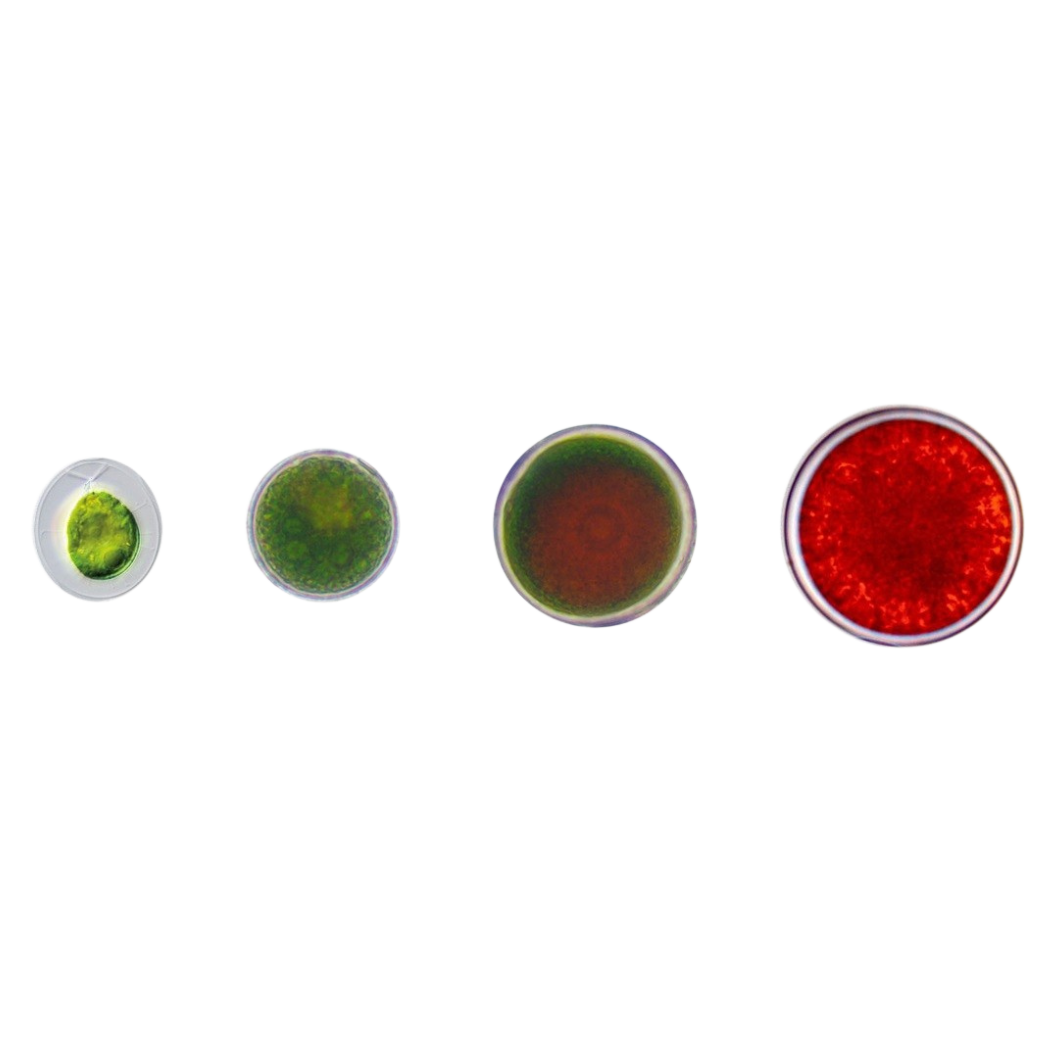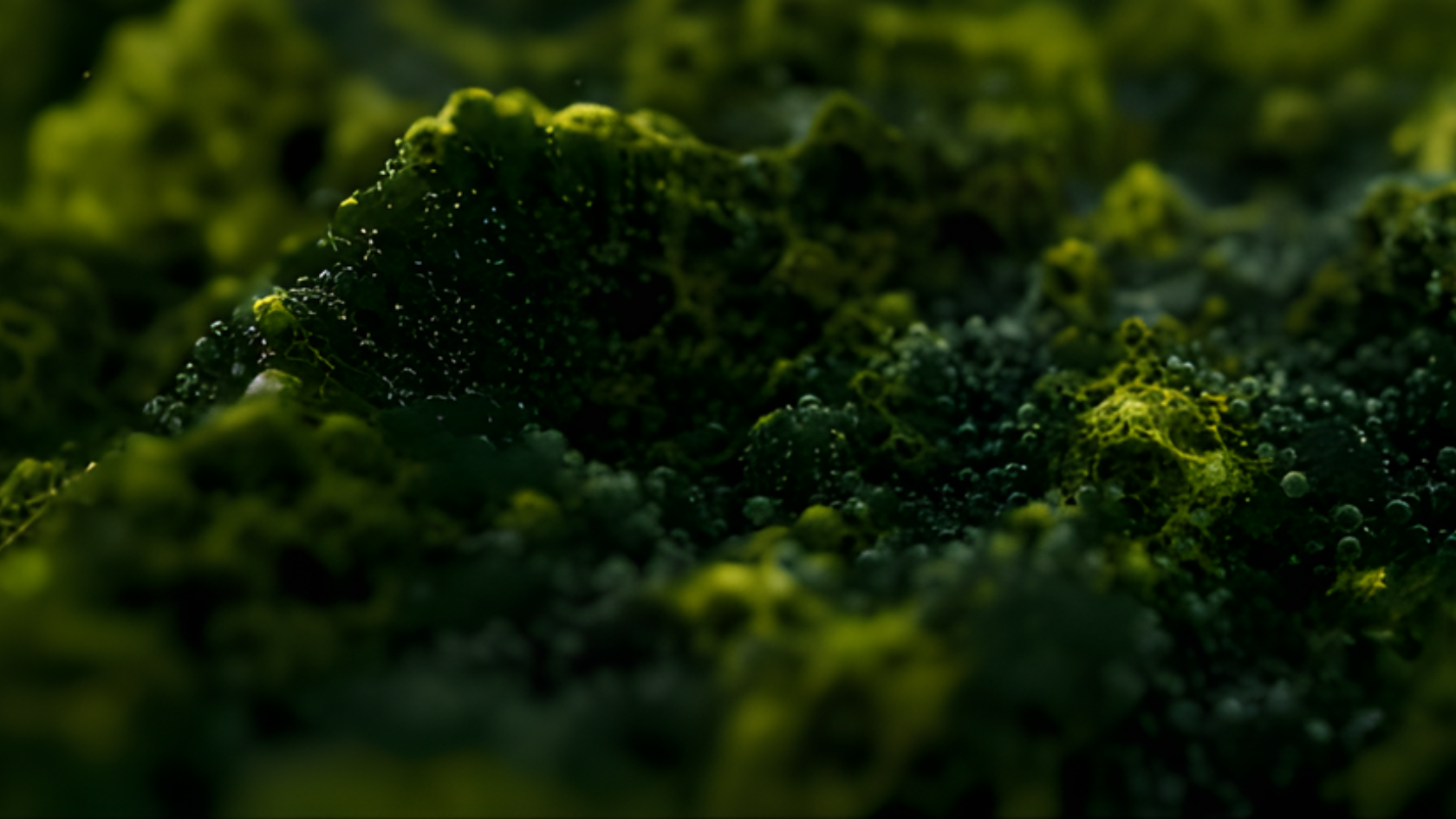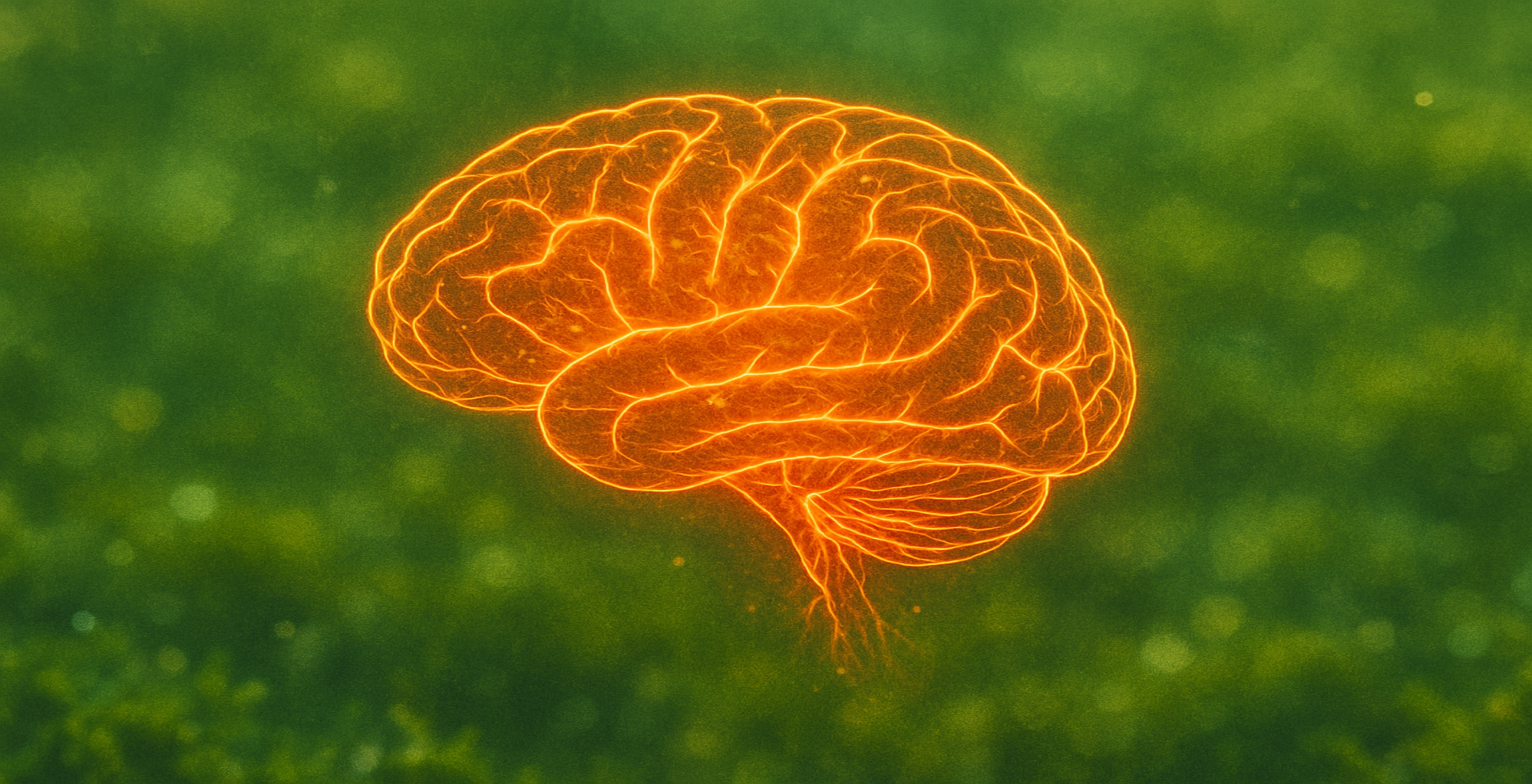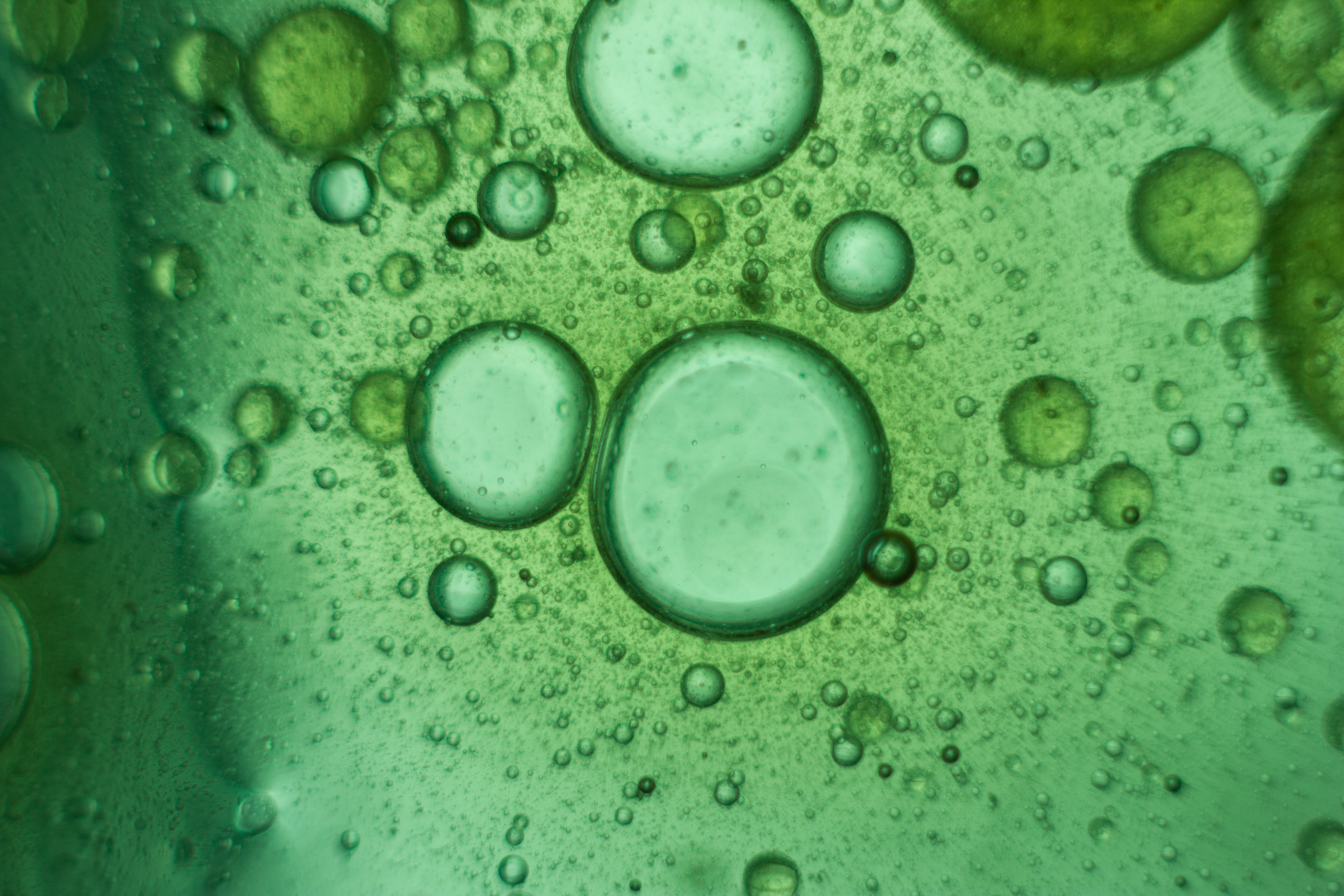
Maarten Muys
Dr. ir. Maarten Muys holds a masters degree in Environmental Technology and a PhD in Bioengineering. He specialized in sustainable microbial protein production and microalgae cultivation. Maarten has amassed over 12 years of experience in algae cultivation and has published numerous paper on the topic.
Astaxanthin Benefits: Comprehensive Guide to Health Effects and Uses
In the quest for optimal health and longevity, one natural compound is gaining international acclaim for its remarkable benefits: astaxanthin.
This remarkable carotenoid doesn't just match the free-radical fighting power of other antioxidants—it dramatically exceeds them. With antioxidant activity up to 6,000 times more potent than vitamin C and 550 times stronger than vitamin E, astaxanthin represents a genuine breakthrough in natural health innovation.1
Found primarily in the microalgae Haematococcus pluvialis, astaxanthin is a potent antioxidant known for its vibrant red pigment and exceptional ability to quench free radicals. Unlike other antioxidants, this carotenoid covers both water-soluble and fat-soluble parts of cells, offering comprehensive cellular protection.
This introductory guide deep dives into the origins, science, and extensive health benefits of astaxanthin, highlighting its unique properties and the cutting-edge technology that enhances its efficacy and accessibility.
Whether you're a health enthusiast or a professional in the wellness industry, understanding astaxanthin's role in health and disease prevention can empower you to make informed decisions about incorporating this powerhouse into your regimen.
What Is Astaxanthin?
Astaxanthin (pronounced asta-ZAN-thin) belongs to the carotenoid family, a group of natural pigments responsible for the vibrant colors in many foods. But unlike more common carotenoids like beta-carotene, astaxanthin possesses a unique molecular structure that gives it extraordinary antioxidant capabilities.
The secret to astaxanthin's power lies in its distinctive molecular design. While most antioxidants work either in water-soluble or fat-soluble environments, astaxanthin functions in both—allowing it to protect cellular membranes from free radical damage with remarkable efficiency. Its unique structure spans the entire cell membrane, providing protection from both the inside and outside of cells.2
Where Does Natural Astaxanthin Come From?
In nature, astaxanthin is primarily produced by microalgae, particularly Haematococcus pluvialis, which synthesizes the compound as a protective response to environmental stressors like UV radiation and nutrient deprivation. When these algae face harsh conditions, they transform from green motile cells into red cysts rich in astaxanthin—a survival mechanism that's evolved over billions of years.
What sets astaxanthin apart?
Imagine a vibrant red pigment, hidden away in certain seafoods and responsible for the rosy hue of flamingos and the pink flesh of salmon. But astaxanthin isn't content with just being a pretty face. This molecule is a bona fide cellular bodyguard, providing unparalleled protection against oxidative stress.

This vibrant red pigment then moves up the food chain as various marine creatures consume the algae. It's what gives salmon, crab, shrimp, and flamingos their distinctive pink-to-red coloration. Among these natural sources, the microalgae Haematococcus pluvialis produces the highest concentrations of astaxanthin, making it the preferred source for high-quality supplements.3
Natural vs. Synthetic Astaxanthin: A Critical Distinction
It's crucial to understand that not all astaxanthin is created equal.
Synthetic astaxanthin, produced through petrochemical processes, has a significantly different molecular composition than its natural counterpart—containing different stereoisomers that don't match the form found in nature.
Studies consistently demonstrate that natural astaxanthin offers superior antioxidant capacity and bioavailability compared to synthetic versions. Natural astaxanthin from Haematococcus pluvialis contains primarily the 3S,3'S stereoisomer, which research indicates is the most biologically active form.

By contrast, synthetic astaxanthin contains a mixture of stereoisomers, many of which show reduced biological activity.4
If you want to know more about it, we created an extensive white papers compiling all the studies comparing natural vs synthetic astaxanthin.
How Astaxanthin Works at a Cellular Level
Unlike many antioxidants that become pro-oxidants after neutralizing free radicals, natural astaxanthin remains stable, continuously protecting cells from oxidative damage.
At its core, astaxanthin neutralizes free radicals by donating electrons, stabilizing these harmful molecules without itself becoming unstable. This makes it exceptionally effective at reducing oxidative stress, a key contributor to aging and disease.
The Unique Mechanism of Action in Cell Membranes
One of astaxanthin’s most remarkable properties is its ability to integrate across the entire cell membrane. Unlike typical antioxidants that are either water-soluble (protecting only the cell exterior) or fat-soluble (protecting the inner membrane), astaxanthin spans both layers, offering full membrane protection.
-
Inner Protection: Fat-soluble antioxidants like vitamin E protect only the inner membrane.
-
Outer Defense: Water-soluble antioxidants like vitamin C protect the exterior.
-
Comprehensive Shielding: Astaxanthin bridges both, providing 360-degree membrane stability.
This dual solubility prevents lipid peroxidation and protects essential cellular components like cholesterol and phospholipids, maintaining membrane integrity.
Illustration of astaxanthin spanning both the cell membrane and intra-cellular space of a cell
The Exceptional Health Benefits of Natural Astaxanthin
Natural astaxanthin's unique properties translate into an impressive range of health benefits supported by over 2,000 peer-reviewed studies. Here's how this remarkable compound supports whole-body health:
Discover all astaxanthin benefits in detail
Unparalleled Antioxidant Protection
Free radicals—unstable molecules that damage cells through oxidative stress—are implicated in numerous chronic diseases and accelerated aging. Astaxanthin neutralizes these harmful molecules with an efficiency that surpasses traditional antioxidants by orders of magnitude:
- 6,000 times more potent than vitamin C
- 550 times stronger than vitamin E
- 75 times more powerful than alpha-lipoic acid
- 40 times more effective than beta-carotene
But astaxanthin's antioxidant capabilities extend beyond mere numbers. Unlike some antioxidants that can become pro-oxidants under certain conditions, astaxanthin never exhibits pro-oxidant activity, making it exceptionally safe even at high doses.5

Illustration of the ORAC value (a measure of antioxidant capacity) of natural astaxanthin vs others antioxidants
Powerful Anti-Inflammatory Support
Chronic inflammation underlies many of today's most prevalent health challenges, from cardiovascular disease to arthritis. Natural astaxanthin helps modulate inflammatory responses by inhibiting multiple inflammation pathways, including the NF-κB signaling pathway and the production of inflammatory cytokines.
This multi-pathway approach makes astaxanthin particularly valuable for addressing chronic inflammation without the side effects associated with pharmaceutical interventions. Multiple clinical studies demonstrate astaxanthin's ability to reduce inflammatory markers like C-reactive protein (CRP) and TNF-alpha while supporting balanced immune function.6
Cellular Energy Production Enhancement
Mitochondria—the cellular powerhouses—become less efficient with age and oxidative stress. Astaxanthin has been shown to protect mitochondrial membranes and enhance energy production, potentially improving cellular efficiency and overall vitality.
By preserving mitochondrial function, astaxanthin may help maintain cellular energy production, particularly important for high-energy organs like the heart and brain.7
How Astaxanthin Supports Total Body Health
The versatility of astaxanthin is perhaps its most remarkable feature, with benefits that extend across multiple body systems. If you want to know more, we made a white paper with all the science-backed benefits of natural astaxanthin than can help you save hours looking for the right information or clinical study.
1. Astaxanthin for Skin Health and Beauty
Healthy skin isn’t just about aesthetics — it’s a visible reflection of cellular health, oxidative balance, and inflammation control.
Astaxanthin is one of the only natural compounds shown to significantly improve multiple skin parameters from the inside out, thanks to its unique molecular structure and antioxidant power.
Unlike collagen powders or topical creams, astaxanthin works at the cellular level, protecting skin cells against oxidative damage, preserving collagen integrity, and supporting hydration, elasticity, and resistance to UV-induced aging.
Clinical studies show that astaxanthin can:
- Reduces wrinkles and age spots: In a randomized, double-blind, placebo-controlled study, Tominaga et al. (2012) demonstrated that 6 mg/day of natural astaxanthin significantly reduced the appearance of fine lines, improved skin elasticity, and decreased age spot size in healthy women over an 8-week period.8
- Improves skin elasticity and moisture content: A systematic review and meta-analysis by Zhou et al. (2021) concluded that astaxanthin supplementation significantly enhances skin elasticity and increases moisture content, contributing to overall skin health and appearance.9
- Protects against UV-induced skin damage: Ito et al. (2018) conducted a randomized, double-blind, placebo-controlled trial and found that astaxanthin supplementation increased the minimal erythema dose (MED), indicating enhanced resistance to UV-induced skin deterioration.10
These benefits stem from astaxanthin's ability to protect collagen from degradation while reducing the activity of enzymes that break down dermal tissues.
For brands developing anti-aging, beauty-from-within, or sun protection supplements, astaxanthin offers unmatched versatility: hydration, elasticity, wrinkle reduction, and UV resilience — all from one ingredient.
Astaxanthin is one of the few ingredients that support both visible skin improvements and deeper cellular protection. Indeed, its antioxidant effects extend deep into skin cells, improving their resilience and repair rate.
Unlike topical treatments that work only on the surface, oral astaxanthin nourishes skin from the inside out, its systemic action supports skin tone, clarity, and resilience.
You can deep dive on the benefits on astaxanthin on skin-health, learning everything about what results to expect, importance of production methods, and synergistic effects with other molecule like collagen on our article.
2. Vision and Eye Health Support
Between constant screen time, UV exposure, and oxidative stress, your eyes are under siege daily — especially if you’re working long hours in front of digital devices.
Most people rely on short-term fixes like artificial tears or blue light filters. But what if you could protect your eyes from within, at the cellular level?
That’s exactly what astaxanthin does.
Unlike typical antioxidants, astaxanthin crosses the blood-retinal barrier, reaching the retina, photoreceptor cells, and ocular capillaries — where oxidative damage begins. This makes it one of the few natural compounds with real, systemic impact on long-term eye health
Backed by Clinical Research
-
Reduces digital eye fatigue and strain: In a randomized study, Nagaki et al. (2002) showed that 6 mg of astaxanthin daily for 4 weeks significantly reduced visual fatigue in VDT (visual display terminal) workers — improving both accommodation time and critical flicker fusion.11
-
Protects retinal cells from light-induced oxidative damage: Nakajima et al. (2008) demonstrated astaxanthin’s ability to shield retinal neurons from phototoxicity in vitro and in vivo, suggesting its value in preventing long-term degenerative changes.12
-
Improves microcirculation in ocular tissues: Nagaki et al. (2005) found that astaxanthin enhances capillary blood flow in the retina, which is essential for nutrient delivery and visual endurance under strain.13
Your eyes are an extension of your brain — highly vascularized, mitochondria-dense, and incredibly active. The same oxidative stress that contributes to fatigue, dryness, and blurriness today can accelerate age-related macular degeneration and glaucoma tomorrow.
Whether you’re building a next-gen eye supplement or looking to enhance cognitive + visual performance in your product line, natural astaxanthin delivers full-spectrum protection: from daily screen fatigue to deep retinal support.
And unlike ingredients like lutein or zeaxanthin that act only on surface or lens-level functions, astaxanthin offers multilayer protection — at the vascular, cellular, and mitochondrial levels.
3. Cardiovascular System Optimization
Cardiovascular disease remains the leading cause of mortality worldwide, driven by a mix of poor lipid profiles, chronic inflammation, oxidative stress, and endothelial dysfunction.
Natural astaxanthin stands out as one of the few compounds with the ability to target all four mechanisms simultaneously — offering a truly multi-pronged strategy for cardiovascular health maintenance and prevention:
-
Improves Blood Lipids: In a double-blind, placebo-controlled study, Yoshida et al. (2010) showed that 12 mg/day of natural astaxanthin significantly increased HDL-C and reduced triglycerides and LDL oxidation in patients with mild hyperlipidemia.14
-
Reduces Arterial Stiffness and Enhances Blood Flow: Kishimoto et al. (2016) found that astaxanthin supplementation improved endothelial function and reduced pulse wave velocity, indicating lower arterial stiffness — a key predictor of cardiovascular events.15
-
Protects Against LDL Oxidation and Atherosclerosis Progression: In their review, Fassett & Coombes (2011) concluded that astaxanthin has “clear potential” as a therapeutic antioxidant for vascular protection, due to its unique ability to prevent oxidation of LDL cholesterol, a critical initiator of plaque formation.16
Why it matters for product development?
For brands developing heart health supplements, astaxanthin offers a rare combination of preventive, protective, and restorative mechanisms — backed by over a decade of clinical research.
Its natural origin, superior bioavailability, and antioxidant power position it as a next-gen ingredient for cardiovascular formulas that deliver on both performance and consumer trust.
With axabio’s stable, high-purity astaxanthin, you can confidently formulate products designed to support cholesterol balance, arterial elasticity, and long-term heart resilience — without synthetic compounds or complex stacks.
4. Brain Function and Cognitive Performance
With its exceptionally high oxygen demand and lipid-rich structure, the brain is particularly susceptible to oxidative stress — a key driver of cognitive decline and neurodegeneration.
Unlike most antioxidants, astaxanthin can cross the blood-brain barrier, allowing it to exert protective effects directly within neural tissues.
Astaxanthin supports brain health through multiple synergistic mechanisms:
-
Protects Neurons from Oxidative Damage: In a comprehensive review, Wu et al. (2015) highlighted astaxanthin’s ability to protect neurons from oxidative stress by scavenging free radicals and reducing lipid peroxidation in brain tissues. These neuroprotective effects help preserve memory and cognitive performance under conditions of oxidative burden.17
-
Improves Cerebral Blood Flow: Nishimura et al. (2018) demonstrated that astaxanthin supplementation enhanced blood flow in the cerebral cortex by improving endothelial function and reducing oxidative stress, facilitating better oxygen and nutrient delivery to brain cells.37
-
Reduces Neuroinflammation: In a recent study, Dong et al. (2022) showed that astaxanthin significantly reduced levels of pro-inflammatory cytokines (such as TNF-α and IL-6) in the brain, helping to mitigate inflammation-related cognitive decline.38
-
Supports Mitochondrial Function in Brain Cells: Fakhri et al. (2019) reviewed astaxanthin’s role in mitochondrial protection, showing it enhances ATP production, stabilizes mitochondrial membranes, and reduces ROS generation — critical factors in maintaining brain energy metabolism and neuroplasticity.39
As scientific interest in nootropic and longevity compounds grows, natural astaxanthin stands out as a promising ingredient for cognitive support — especially in aging populations or those exposed to high oxidative burden.
For learning more about the health benefits of astaxanthin on brain and cognitive health, your can read our dedicated article.
5. Athletic Performance and Recovery Enhancement
For both professional athletes and active individuals, astaxanthin offers significant benefits for performance and recovery:
- Reduces exercise-induced muscle damage and soreness
- Improves strength and endurance
- Enhances fat utilization during exercise
- Accelerates recovery between training sessions
These benefits result from astaxanthin's ability to protect muscle tissue from oxidative damage during exertion while supporting efficient energy production and reducing inflammatory responses that can delay recovery. 18 19 20
Recent studies reinforce these performance-enhancing effects:
- A 2023 clinical trial by Barker et al. found that astaxanthin supplementation significantly reduced muscle soreness after eccentric resistance training in well-conditioned athletes, highlighting its impact on perceived recovery.18
- In a double-blind trial published in the International Journal of Sports Medicine, Earnest et al. showed that daily astaxanthin (4 mg) improved cycling time trial performance, suggesting better endurance and energy efficiency.19
- Aoi et al. showed that astaxanthin improves fat metabolism during exercise by preventing oxidative modification of CPT I, a key enzyme involved in lipid utilization. 20
Together, these findings confirm that natural astaxanthin supplements can play a vital role in athletic recovery, fat metabolism, and performance — whether you’re training for competition or simply maintaining an active lifestyle.
6. Immune System Balance and Support
Modern immune challenges — from environmental stressors to chronic inflammation — demand more than just short-term solutions. That’s where natural astaxanthin stands out: not only as a potent antioxidant, but as a multi-targeted compound that actively supports immune resilience and balance.
Unlike many one-dimensional immune supplements, astaxanthin works across multiple immune pathways simultaneously, making it one of the most comprehensive options available for immune support backed by science.
Here’s how astaxanthin enhances immune performance through several well-documented mechanisms:
-
Enhances antibody and cytokine production, helping regulate immune response and communication between cells. Park et al. (2010) found that astaxanthin increased immune markers including IL-6, IFN-γ, and IgA in healthy adults. 21
-
Increases the number and activity of natural killer (NK) cells, which play a crucial role in first-line immune defense. Goyal et al. (2022) summarized astaxanthin’s immunomodulatory effects, including enhanced NK cell activation. 22
-
Modulates inflammatory responses by downregulating pro-inflammatory pathways like NF-κB and cytokines such as TNF-α. Jia et al. (2022) showed astaxanthin’s dual regulation of Nrf2 and NF-κB signaling pathways to control inflammation. 23
-
Protects immune cells from oxidative stress, preserving function under challenging conditions. In their study, Jin et al. (2020) reported that astaxanthin significantly reduced oxidative damage in immune cell mitochondria. 24
This balanced, multi-targeted approach helps maintain robust immune defenses while preventing excessive inflammatory responses that could contribute to autoimmune or chronic inflammatory conditions. Natural astaxanthin thus offers a unique, safe, and effective strategy for supporting overall immune health.
The Future of Astaxanthin Research
Scientific interest in astaxanthin continues to accelerate, with recent studies exploring exciting new applications:
1. Metabolic Health and Weight Management
Emerging research indicates that astaxanthin, a potent antioxidant, may support healthy weight management and metabolic function through several mechanisms:
These findings suggest that astaxanthin supplementation may offer beneficial effects on insulin sensitivity, visceral fat reduction, and fat metabolism, supporting overall metabolic health.
2. Gut Health and Microbiome Support
Preliminary studies suggest that astaxanthin may play a beneficial role in gut health by supporting a balanced microbiome composition and strengthening intestinal barrier function.
As a potent antioxidant and anti-inflammatory compound, astaxanthin has been shown to modulate gut microbiota, fostering the growth of beneficial bacterial strains while reducing pro-inflammatory microbes 28. This shift in microbial diversity may contribute to improved metabolic health, enhanced nutrient absorption, and better immune function 29.
Additionally, astaxanthin helps protect intestinal epithelial cells from oxidative stress, which is a key factor in conditions like leaky gut syndrome and inflammatory bowel disease (IBD). By reducing gut inflammation and inhibiting oxidative damage to intestinal cells, astaxanthin may reinforce the integrity of tight junction proteins 30, which are essential for maintaining a healthy intestinal barrier. This protective effect could potentially reduce intestinal permeability, preventing harmful bacteria and toxins from leaking into the bloodstream—a phenomenon linked to chronic inflammation and metabolic disorders.
This promising area of research suggests that astaxanthin could be a valuable natural compound for digestive wellness, gut microbiome optimization, and long-term metabolic function.
3. Healthy Aging and Longevity Pathways
Emerging research indicates that astaxanthin may influence several key cellular pathways associated with longevity, including FOXO3, Nrf2, and sirtuin activation 31. These pathways are critical in regulating cellular repair mechanisms, oxidative stress resilience, and metabolic balance, all of which play a role in healthy aging and longevity 32.
• FOXO3 Activation: FOXO3 is one of the most well-established longevity genes, linked to lifespan extension in multiple species. Astaxanthin has been shown to enhance FOXO3 expression, which contributes to increased resistance against oxidative stress and improved cellular maintenance 33.
• Nrf2 Pathway Modulation: Nrf2 is the master regulator of antioxidant defense. Astaxanthin activates the Nrf2 pathway, leading to an upregulation of antioxidant enzymes such as superoxide dismutase (SOD) and catalase (CAT), which help neutralize reactive oxygen species and prevent cellular damage 34.
- Sirtuin Activation: Sirtuins (SIRT1 and SIRT3) are crucial for metabolic regulation and mitochondrial function. Astaxanthin has been reported to enhance sirtuin activity, supporting energy production, inflammation control, and cellular longevity 35.
By influencing these longevity-associated pathways, astaxanthin may contribute to slowing down age-related cellular decline, improving mitochondrial health, and enhancing systemic resilience against oxidative stress and inflammation 36. While further human studies are needed, these findings suggest astaxanthin holds promise as a natural longevity-supporting compound.
Conclusion: Astaxanthin's Transformative Potential
As both scientific understanding and production technology advance, natural astaxanthin stands poised to transform preventative health approaches worldwide. With its exceptional safety profile, comprehensive research support, and wide-ranging benefits, As a clinically supported supplement, it stands out for its bioavailability and proven effectiveness.astaxanthin represents a true breakthrough in natural health innovation.
For formulators, R&D professionals, and company leaders seeking cutting-edge natural ingredients with solid scientific backing, astaxanthin—particularly in the pure, sustainable form pioneered by axabio—offers an unparalleled opportunity to develop products that genuinely improve consumer health while maintaining the highest standards of environmental responsibility.
To learn more about incorporating axabio's premium natural astaxanthin into your formulations or to discuss partnership opportunities, visit our website or contact our scientific team directly to discuss your specific formulation needs.
FAQ
Frequently Asked Questions About Astaxanthin-
Astaxanthin has a unique molecular structure that allows it to function in both water and fat-soluble environments, spanning cell membranes to provide protection from both inside and outside. It's up to 6,000 times more potent than vitamin C and 550 times stronger than vitamin E as an antioxidant, and never exhibits pro-oxidant activity, unlike some other antioxidants.
-
Natural astaxanthin, primarily from Haematococcus pluvialis, contains the 3S,3'S stereoisomer which research indicates is the most biologically active form. Synthetic astaxanthin, produced through petrochemical processes, contains a mixture of stereoisomers with reduced biological activity, resulting in inferior antioxidant capacity and bioavailability compared to natural sources.
-
Astaxanthin protects skin against UV damage, reduces wrinkles and fine lines, improves skin elasticity and moisture content, diminishes age spots and hyperpigmentation, and protects collagen from degradation. Unlike topical treatments, oral astaxanthin works from the inside out to nourish skin cells at their foundation.
-
Yes, astaxanthin readily crosses the blood-retinal barrier and provides protection to photoreceptor cells. Research demonstrates it can reduce eye fatigue and strain from digital screen use, support healthy intraocular pressure, protect retinal cells from light-induced damage, and improve capillary blood flow in the eyes.
-
Astaxanthin reduces exercise-induced muscle damage and soreness, improves strength and endurance, enhances fat utilization during exercise, and accelerates recovery between training sessions. These benefits result from astaxanthin's ability to protect muscle tissue from oxidative damage during exertion while supporting efficient energy production and reducing inflammatory responses.
-
Astaxanthin improves cardiovascular health by enhancing blood lipid profiles (raising HDL while lowering LDL), enhancing blood flow and reducing arterial stiffness, protecting LDL cholesterol from oxidation (a key factor in atherosclerosis development), and supporting healthy blood pressure by improving endothelial function.
-
Emerging research suggests astaxanthin may help improve insulin sensitivity and reduce visceral fat accumulation for metabolic health, support a healthy gut microbiome while protecting intestinal barrier function, and influence cellular pathways associated with longevity including FOXO3, Nrf2, and sirtuin activation that contribute to healthy aging across multiple systems.
-
Most clinical studies show measurable results within 2-8 weeks of consistent supplementation. Some effects, particularly related to skin appearance and exercise recovery, may become noticeable within 2-4 weeks, while others like cardiovascular benefits may take 8-12 weeks of regular use to fully manifest.
-
Research indicates astaxanthin may support longevity through multiple mechanisms. It activates the FOXO3 gene (known as the "longevity gene"), enhances mitochondrial function to maintain cellular energy production as we age, reduces age-related oxidative damage to cellular DNA, and modulates inflammatory pathways that accelerate aging processes. Studies in model organisms have shown astaxanthin supplementation can increase lifespan, while human trials demonstrate its ability to protect against age-related decline in various biological systems.
%20(2).png)
Download our research review on natural vs synthetic astaxanthin
In this comprehensive review, we'll take you through the all the most relevant studies and papers comparing natural vs synthetic astaxanthin so that you can make an educated, science-based choice when picking your astaxanthin.
References
- Ambati RR, Phang SM, Ravi S, Aswathanarayana RG. Astaxanthin: sources, extraction, stability, biological activities and its commercial applications--a review. Mar Drugs. 2014;12(1):128-152. doi:10.3390/md12010128
- Goto S, Kogure K, Abe K, et al. Efficient radical trapping at the surface and inside the phospholipid membrane: implications for antioxidant function of carotenoids. J Biol Chem. 2001;276(48):46149-46154. doi:10.1074/jbc.M106774200.
-
Kiperstok AC, Moraes L, Bastos RG, et al. Astaxanthin accumulation in the green microalga Haematococcus pluvialis: effect of phosphate concentration, light intensity and photoperiod. Appl Microbiol Biotechnol. 2020;104(24):10213-10227. doi:10.1007/s00253-020-10956-0.
-
Capelli B, Bagchi D, Cysewski GR. Synthetic astaxanthin is significantly inferior to algal-based astaxanthin as an antioxidant and may not be suitable as a human nutraceutical supplement. Nutrafoods. 2013;12(4):145-152.
- Dose J, Matsugo S, Yokokawa H, et al. Free Radical Scavenging and Cellular Antioxidant Properties of Astaxanthin. Int J Mol Sci. 2016;17(1):103. doi:10.3390/ijms17010103
- Park JS, Chyun JH, Kim YK, Line LL, Chew BP. Astaxanthin decreased oxidative stress and inflammation and enhanced immune response in humans. Nutr Metab (Lond). 2010;7:18. doi:10.1186/1743-7075-7-18
- Wolf AM, Asoh S, Hiranuma H, et al. Astaxanthin protects mitochondrial redox state and functional integrity against oxidative stress. J Nutr Biochem. 2010;21(5):381-389. doi:10.1016/j.jnutbio.2009.01.011
- Tominaga K, Hongo N, Karato M, Yamashita E. Cosmetic benefits of astaxanthin on humans subjects. Acta Biochim Pol. 2012;59(1):43-47.
-
Suganuma K, Nakajima H, Ohtsuki M, Imokawa G. Astaxanthin reduces matrix metalloproteinase expression in human dermal fibroblasts: A key factor in maintaining skin integrity. J Biochem Mol Toxicol. 2010;24(1):1-8. doi:10.1002/jbt.20364.
-
Kim SH, Kim HS, Kim DJ, Kim HG, Hwang KE, Kim YS. Astaxanthin inhibits matrix metalloproteinase expression by suppressing the PI3K/AKT/mTOR/NF-κB pathways in human dermal fibroblasts. Yonsei Med J. 2018;59(7):862-869. doi:10.3349/ymj.2018.59.7.862.
- Nagaki Y, Hayasaka S, Yamada T, et al. Effects of astaxanthin on accommodation, critical flicker fusion, and pattern visual evoked potential in visual display terminal workers. J Trad Med. 2002;19:170–173.
-
Nakajima Y, Inokuchi Y, Shimazawa M, et al. Astaxanthin, a dietary carotenoid, protects retinal cells against oxidative stress in vitro and in mice in vivo. Invest Ophthalmol Vis Sci. 2008;49(4):1679-1685. doi:10.1167/iovs.07-0862.
-
Nagaki Y, Mihara M, Okamoto N, et al. The effect of astaxanthin on retinal capillary blood flow in normal volunteers. J Clin Ther Med. 2005;21(5):537-542.
- Yoshida H, Yanai H, Ito K, et al. Administration of natural astaxanthin increases serum HDL-cholesterol and adiponectin in subjects with mild hyperlipidemia. Atherosclerosis. 2010;209(2):520-523. doi:10.1016/j.atherosclerosis.2009.10.012
-
Kishimoto Y, Yoshida H, Kondo K. Potential Anti-Atherosclerotic Properties of Astaxanthin. Mar Drugs. 2016;14(2):35. doi:10.3390/md14020035.
-
Fassett RG, Coombes JS. Astaxanthin: A potential therapeutic agent in cardiovascular disease. Mar Drugs. 2011;9(3):447-465. doi:10.3390/md9030447.
- Wu H, Niu H, Shao A, et al. Astaxanthin as a Potential Neuroprotective Agent for Neurological Diseases. Mar Drugs. 2015;13(9):5750-5766. doi:10.3390/md13095750
-
Barker GA, Parten AL, Lara DA, et al. Astaxanthin Supplementation Reduces Subjective Markers of Muscle Soreness following Eccentric Exercise in Resistance-Trained Men. Muscles. 2023;2(2):228-237. doi:10.3390/muscles2020017
-
Earnest CP, Lupo M, White KM, Church TS. Effect of Astaxanthin on Cycling Time Trial Performance. Int J Sports Med. 2011;32(11):882-888. doi:10.1055/s-0031-1279778.
- Aoi W, Naito Y, Takanami Y, et al. Astaxanthin improves muscle lipid metabolism in exercise via inhibitory effect of oxidative CPT I modification. Biochem Biophys Res Commun. 2008;366(4):892-897. doi:10.1016/j.bbrc.2007.12.019
-
Goyal A, Sharma V, Upadhyay N, Gill S, Sihag M. Astaxanthin as a potential immunomodulatory compound: A molecular perspective. Molecules. 2022;27(2):502. doi:10.3390/molecules27020502.
-
Park JS, Chyun JH, Kim YK, Line LL, Chew BP. Astaxanthin decreased oxidative stress and inflammation and enhanced immune response in humans. Nutr Metab (Lond). 2010;7:18. doi:10.1186/1743-7075-7-18.
-
Jia Y, Wang X, Hu D, Wang Y, Liu X. Astaxanthin modulates inflammatory response via the NF-κB and Nrf2 pathways: A potential therapeutic strategy for inflammatory diseases. Front Pharmacol. 2022;13:916653. doi:10.3389/fphar.2022.916653.
-
Jin Y, Wang R, Yang S, et al. Astaxanthin protects immune cells from oxidative stress and enhances immune function. Int J Mol Med. 2020;46(3):1075-1085. doi:10.3892/ijmm.2020.4783.
-
Iwabayashi M, Fujioka N, Nomoto K, Harigae T, Kanda S. Effects of astaxanthin in obese individuals with impaired insulin sensitivity. Asia Pac J Clin Nutr. 2018;27(2):341-346. doi:10.6133/apjcn.062017.08.
-
Yoshida H, Yanai H, Ito K, et al. Astaxanthin improves glycemic control and reduces oxidative stress in healthy volunteers. Nutrients. 2021;13(12):4346. doi:10.3390/nu13124346.
-
Ni Y, Nagashimada M, Zhuge F, et al. Astaxanthin prevents diet-induced insulin resistance and steatohepatitis in mice: A comparison with vitamin E. Mar Drugs. 2023;23(1):9. doi:10.3390/md23010009.
-
Liu Y, Liu S, Chen H, et al. Astaxanthin From Haematococcus pluvialis Prevents High-Fat Diet-Induced Hepatic Steatosis and Oxidative Stress by Modulating the Gut-Liver Axis. Front Nutr. 2022;8:840648. doi:10.3389/fnut.2022.840648.
-
Yang Y, Kim B, Lee JY. Astaxanthin-Shifted Gut Microbiota Is Associated with Inflammation and Metabolic Homeostasis in BCO2 Knockout Mice. J Nutr. 2020;150(11):2790-2798. doi:10.1093/jn/nxaa247.
-
Zhang X, Wang L, Zhang L, et al. Astaxanthin n-Octanoic Acid Diester Ameliorates Insulin Resistance and Modulates Gut Microbiota in High-Fat and High-Sucrose Diet-Fed Mice. Int J Mol Sci. 2020;21(6):2149. doi:10.3390/ijms21062149.
-
Sorrenti V, Davinelli S, Scapagnini G, et al. Astaxanthin as a Putative Geroprotector: Molecular Basis and Focus on Brain Aging. Mar Drugs. 2020;18(7):351. doi:10.3390/md18070351.
-
Willcox BJ, Willcox DC, Allsopp RC, et al. FOXO3: A Major Gene for Human Longevity—A Mini-Review. Gerontology. 2016;62(2):109-114. doi:10.1159/000437378.
-
Miyazaki K, Oikawa N, Saito A, et al. Astaxanthin promotes longevity and stress resistance via FOXO3 activation in C. elegans. Exp Gerontol. 2021;146:111224. doi:10.1016/j.exger.2021.111224.
-
Kanwugu ON, Glukhareva TV. Activation of Nrf2 Pathway as a Protective Mechanism Against Oxidative Stress-Induced Diseases: Potential of Astaxanthin. Arch Biochem Biophys. 2023;741:109601. doi:10.1016/j.abb.2023.109601.
-
Kauppinen A, Suuronen T, Ojala J, et al. Antagonistic crosstalk between NF-κB and SIRT1 in the regulation of inflammation and metabolic disorders. Cell Signal. 2013;25(10):1939-1948. doi:10.1016/j.cellsig.2013.06.007.
- Sztretye M, Dienes B, Gönczi M, et al. Astaxanthin: A Potential Mitochondrial-Targeted Antioxidant Treatment in Diseases and with Aging. Oxid Med Cell Longev. 2019;2019:3849692. doi:10.1155/2019/3849692
-
Nishimura, Y., Morikawa, T., Nakamura, A., Inoue, Y., & Matsumoto, K. (2018). Antioxidant and Anti-Inflammatory Activity of Astaxanthin Improves Motor Function in Mice with Spinal Cord Injury. Journal of Clinical Biochemistry and Nutrition, 62(2), 101–107. https://doi.org/10.3164/jcbn.17-116
-
Dong, H., Zhou, H., Zhao, Y., Wang, Y., & Zhang, L. (2022). Astaxanthin Alleviates Neuroinflammation by Inhibiting the NLRP3 Inflammasome Pathway in BV-2 Microglial Cells. International Journal of Molecular Sciences, 23(16), 9433. https://doi.org/10.3390/ijms2316943
-
Fakhri, S., Abbaszadeh, F., Dargahi, L., Jorjani, M. (2019). Astaxanthin: A mechanistic review on its biological activities and health benefits. Pharmacological Research, 145, 104–309. https://doi.org/10.1016/j.phrs.2019.104314










